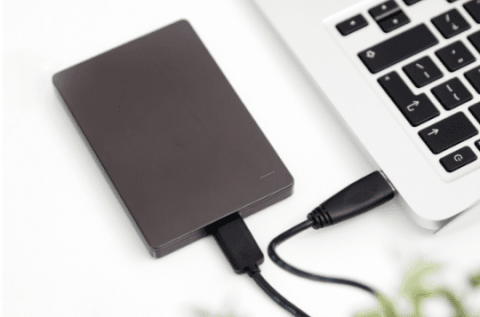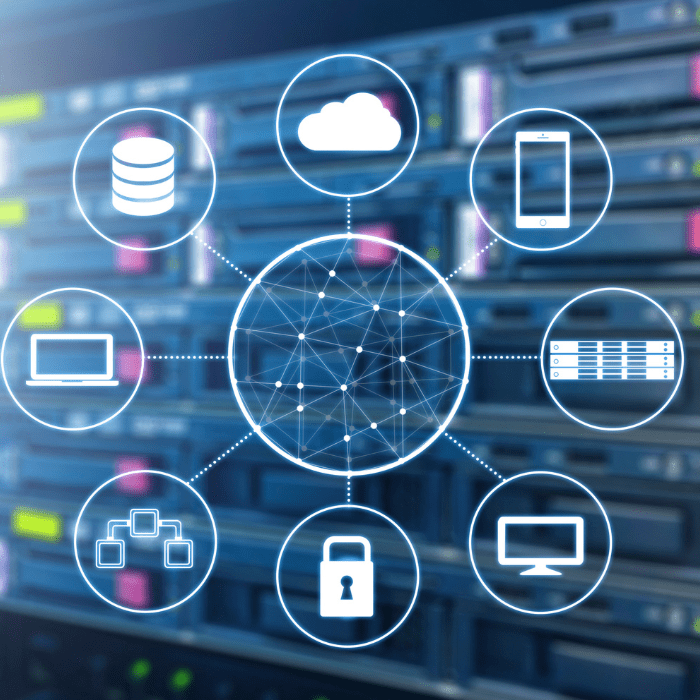An external disk can store important files for work, studies or your personal life. What you expect is to be able to access them easily whenever you need them, not for an error to get in the way.
However, if your external disk doesn’t appear on your computer after plugging it into a USB port, you have a problem… In this situation, there may be a hardware or software fault that is stopping the device from being read.
So what do you do when your laptop doesn’t recognize your external drive? Below, you will learn more about the reasons for this problem and what the solutions are to regain access to the files stored on the device.

Why isn’t my external disk showing up?
Identifying the causes of your external disk not opening on your computer will help you fix this problem. There are several reasons for this, but now let’s take a closer look at the main causes:
System definition failures
It could be that some configuration of the operating system is getting in the way of reading the external disk.
A new or formatted disk, for example, may have been configured for the wrong file pattern, which the system can’t read. Or perhaps it doesn’t have permission to read the contents of the folder, also due to a wrong configuration.
In addition, the Windows drivers that allow the USB to function correctly may be corrupted or out of date.
External disk software failure
Another reason for the computer not recognizing the external drive is a software failure, which prevents access to the stored data or just to some files.
An external disk that is not ejected safely, when attacked by a virus or when there are bad sectors on the disk can present this type of problem. In these cases, care must be taken to repair the disk and recover the stored files without risking losing them.
Hardware problems with the external disk or other devices
The problem of an external disk that won’t open can also be a hardware fault. This problem can be identified in the disk itself, but also in other devices involved, such as the USB port, the cable or the case.
The causes of hardware malfunctions can be dirt, wear and tear from use, a sudden impact that has broken or damaged the parts, among others.
What to do when the external disk doesn’t show up on the PC?
When the external disk doesn’t appear on the PC, it is a sign of a problem. But that doesn’t mean you should despair. First, stay calm, because there are solutions to this problem that will allow you to recover your data.
Some people report that when they connect the external disk to the computer, it doesn’t appear anywhere in the system. However, other reports show that the external disk appears in Disk Manager or Device Manager, but doesn’t open in File Explorer, which also prevents access to the stored data.
That’s why we have provided tips on what to do in each situation:
The external disk does not appear in File Explorer
When the external disk does not appear in File Explorer, you should go to Disk Manager to check what the system is telling you. To do this:
- Type “disk manager” into the Windows search bar;
- Click on “Create and format hard disk partitions”.
If the device appears, you will probably find that it is unallocated, uninitialized or offline. This means that the external disk has been detected, but cannot be accessed.
External disk not booting
An external disk that won’t boot makes the data inaccessible and usually also appears as unallocated. To solve this:
- In Disk Manager, select the external disk;
- Right-click on the uninitialized disk or sector and select the “Initialize disk” option;
- Choose an MBR and GPT partition style and click OK to finish (if you intend to use the disk in different versions of Windows, prefer MBR, because GPT is only supported in Windows 10).
Then, with the tips in the next topic, you can solve the problem of the disk not being allocated, if it still persists.
However, it is important to know that this procedure could erase the data you have already stored on the external disk. So before you do this, save all the files in another backup location.
If you can’t access them to make the backup, use data recovery software, or better still, a company specializing in data recovery such as Bot, which guarantees complete security for this process.
If you would like an assessment of your device, get a quote from us.
Unallocated external disk
When the device is identified as “unallocated”, it means that it is not usable. To solve this problem, you should create partitions on the disk:
- In Disk Manager, select the external disk;
- Right-click on the unallocated sector and select “New simple volume”;
- In the Windows wizard, define the size you want to allocate to this new partition (it can be the total volume of the external disk);
- Assign a new letter to identify the external disk;
- Format the volume with the default configuration and the NTFS, FAT32 or exFAT file system;
- Click Finish.
After that, you will have an allocated external disk. Go to File Explorer to check that the procedure worked and that the device appears.
Once again, it is important to note that if you already have files stored on the external disk, they could be lost with these procedures. So look for a data recovery solution, preferably with a specialized company.
Offline external disk
The external disk may appear as offline in Disk Manager when you mistakenly click to deactivate it or when the disk is under attack by malicious programs. To reactivate it, simply right-click on the disk and select “Online”.
After that, go to File Explorer and see if the disk is available for access.
External disk does not appear in Disk Manager
If your external disk doesn’t appear in Disk Manager or elsewhere on your computer, there are various reasons and solutions. Let’s take a look at some possible solutions to this problem:
Change the USB port or cable
First, check whether the problem is with the hardware of the USB port or the cable. Try using the external disk in another port, on another computer or with another connection cable.
In these cases, the problem isn’t with the external disk, and you won’t have any problems accessing the stored files again. All you need to do is replace the USB port or cable.
Update or correct the drivers
If your laptop doesn’t recognize the external drive, you can try updating the problematic drivers. To do this, follow these steps:
- Type “device manager” into the Windows search bar or open the Device Manager in the Control Panel;
- Expand the Disk Drives category and check if there are any devices with a yellow exclamation mark (if there are, it means that the device has driver problems);
- Right-click on the drive with the problem and select “Update driver”;
- In the Windows wizard, select the option to search for drivers automatically.
Install Windows updates
Your disk may not be recognized because there is a fault in the Windows operating system. More recent updates may have fixed this problem, so you need to install the latest version. To do this:
- Type “windows update” into the Windows search box;
- Click on “Check for updates”.
- If there are any pending updates, install them and restart your computer.
Disable selective USB suspension
Another attempt to repair a disk that doesn’t appear on the PC is to change the device’s power settings. Selective USB sleep is usually enabled by default, which causes the computer to turn off the USB to save power.
However, this could be causing the USB port to malfunction. To correct this problem:
- Type “power plan” in the Windows search bar;
- Click on “Edit a power plan”;
- Click on “Change advanced power settings”;
- Expand the “USB settings” category in the list;
- Expand “Selective USB sleep configuration”;
- Change the settings to “Disabled”, both on battery and plugged in;
- Click Apply to confirm and OK to finish.
Run an antivirus program
One of the most common software problems with external disks is virus and malware attacks. These infections can prevent the device from being read by the PC.
To fix this problem, you can use an antivirus program, which scans the disk for affected sectors and tries to eliminate the invaders. If the procedure works, you’ll find the external disk again in Windows Explorer and Disk Manager.
How do I format an external disk that doesn’t show up?
If you manage to regain access to the disk that didn’t appear on your computer, it is important to ensure that it is safe to store new data. To do this, you need to format the disk.
However, before you start formatting, remember to save all the files stored on the external disk. After all, formatting the disk means cleaning all the data and settings it holds in order to start again from zero – and you probably don’t want to lose any important files.
Formatting is simple:
- Go to File Explorer or Disk Manager;
- Right-click on the external disk storage drive;
- Click on “Format…”;
- Select the NTFS, FAT32 or exFAT file system (exFAT is generally recommended for external disks with more than 4GB of storage).
Anyway, with all the tips we have given you in this article, there is a good chance that you will be able to regain access to the external disk that is not showing up on your computer. However, you may have noticed that some procedures are quite technical and could put your stored data at risk.
So, if you don’t want to run the risk of losing important files, the ideal is to count on professionals who are specialized and experienced in these procedures.
How do I recover data from an external disk that won’t show up?
Often these procedures are not enough to restore access to the data. If the external disk is physically damaged, for example, mechanical intervention is required, which should not be carried out without proper knowledge.
Here at Bot, we have a team qualified to carry out data recovery operations, with all the necessary security, controlled environments and specific equipment. You can send us your device free of charge and receive a free quote.
Now, contact us to find out how we can help you recover your missing external disk and the data stored on it.


